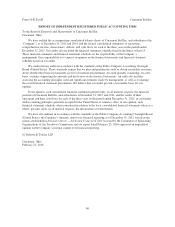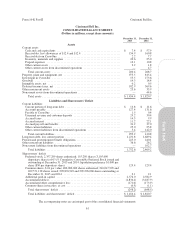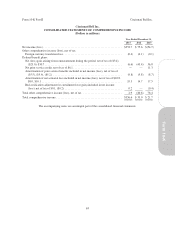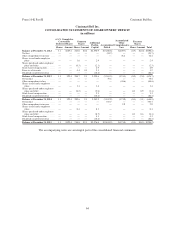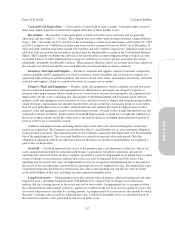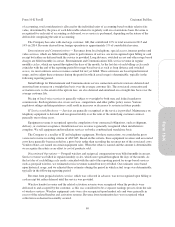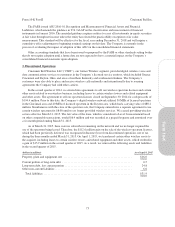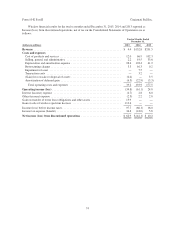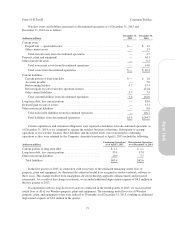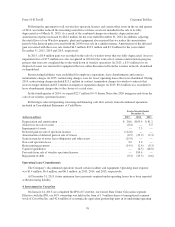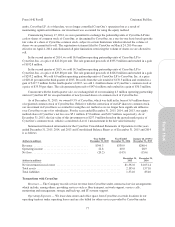Cincinnati Bell 2015 Annual Report Download - page 183
Download and view the complete annual report
Please find page 183 of the 2015 Cincinnati Bell annual report below. You can navigate through the pages in the report by either clicking on the pages listed below, or by using the keyword search tool below to find specific information within the annual report.
Form 10-K Part II Cincinnati Bell Inc.
Cash and Cash Equivalents — Cash consists of funds held in bank accounts. Cash equivalents consist of
short-term, highly liquid investments with original maturities of three months or less.
Receivables — Receivables consist principally of trade receivables from customers and are generally
unsecured and due within 21 – 90 days. The Company has receivables with one large customer, General Electric
Corp. (“GE”), that makes up 22% and 26% of the outstanding accounts receivable balance at December 31, 2015
and 2014, respectively. Unbilled receivables arise from services rendered but not yet billed. As of December 31,
2015 and 2014, unbilled receivables totaled $14.0 million and $13.2 million, respectively. Expected credit losses
related to trade receivables are recorded as an allowance for uncollectible accounts in the Consolidated Balance
Sheets. The Company establishes the allowances for uncollectible accounts using percentages of aged accounts
receivable balances to reflect the historical average of credit losses as well as specific provisions for certain
identifiable, potentially uncollectible balances. When internal collection efforts on accounts have been exhausted,
the accounts are written off and the associated allowance for uncollectible accounts is reduced.
Inventory, Materials and Supplies — Inventory, materials and supplies consists of network components,
various telephony and IT equipment to be sold to customers, wireless handsets and accessories to support our
agreement with Verizon to sell their products and services in our retail stores, maintenance inventories, and other
materials and supplies, which are carried at the lower of average cost or market.
Property, Plant and Equipment — Property, plant and equipment is stated at original cost and presented
net of accumulated depreciation and impairment losses. Maintenance and repairs are charged to expense as
incurred while improvements which extend an asset’s useful life or increase its functionality are capitalized and
depreciated over the asset’s remaining life. The majority of the Entertainment and Communications network
property, plant and equipment used to generate its voice and data revenue is depreciated using the group method,
which develops a depreciation rate annually based on the average useful life of a specific group of assets rather
than for each individual asset as would be utilized under the unit method. Provision for depreciation of other
property, plant and equipment, except for leasehold improvements, is based on the straight-line method over the
estimated economic useful life. Depreciation of leasehold improvements is based on a straight-line method over
the lesser of the economic useful life of the asset or the term of the lease, including optional renewal periods if
renewal of the lease is reasonably assured.
Additions and improvements, including interest and certain labor costs incurred during the construction
period, are capitalized. The Company records the fair value of a legal liability for an asset retirement obligation
in the period it is incurred. The estimated removal cost is initially capitalized and depreciated over the remaining
life of the underlying asset. The associated liability is accreted to its present value each period. Once the
obligation is ultimately settled, any difference between the final cost and the recorded liability is recognized as
gain or loss on disposition.
Goodwill — Goodwill represents the excess of the purchase price consideration over the fair value of net
assets acquired and recorded in connection with business acquisitions. Goodwill is generally allocated to
reporting units one level below business segments. Goodwill is tested for impairment on an annual basis or when
events or changes in circumstances indicate that such assets may be impaired. If the net book value of the
reporting unit exceeds its fair value, an impairment loss may be recognized. An impairment loss is measured as
the excess of the carrying value of goodwill of a reporting unit over its implied fair value. The implied fair value
of goodwill represents the difference between the fair value of the reporting unit and the fair value of all the
assets and liabilities of that unit, including any unrecognized intangible assets.
Long-Lived Assets — Management reviews the carrying value of property, plant and equipment and other
long-lived assets, including intangible assets with definite lives, when events or changes in circumstances
indicate that the carrying amount of the assets may not be recoverable. An impairment loss is recognized when
the estimated future undiscounted cash flows expected to result from the use of an asset (or group of assets) and
its eventual disposition is less than its carrying amount. An impairment loss is measured as the amount by which
the asset’s carrying value exceeds its estimated fair value. Long-lived intangible assets are amortized based on
the estimated economic value generated by the asset in future years.
67
Form 10-K





